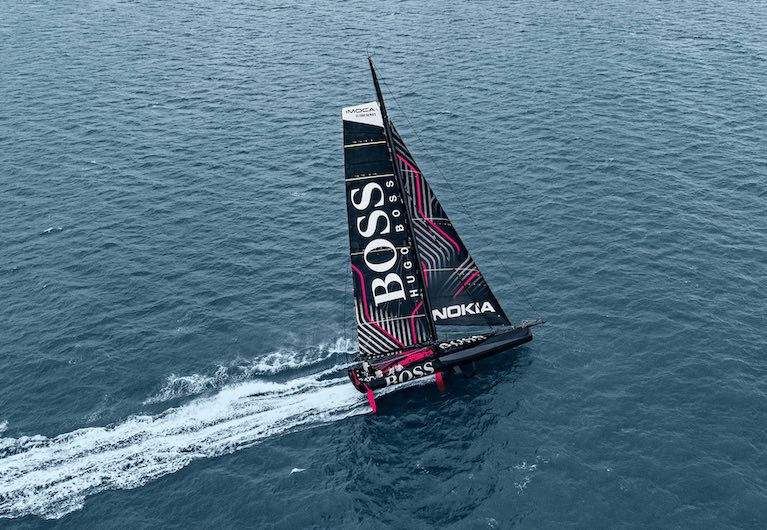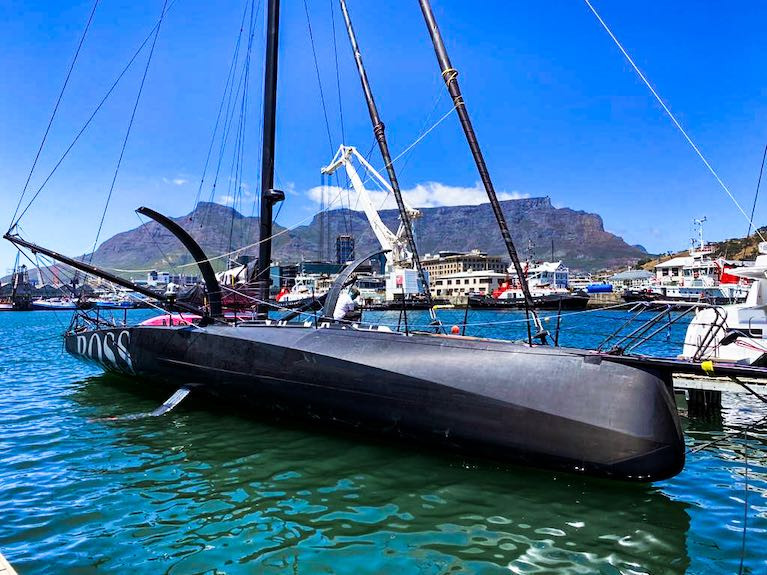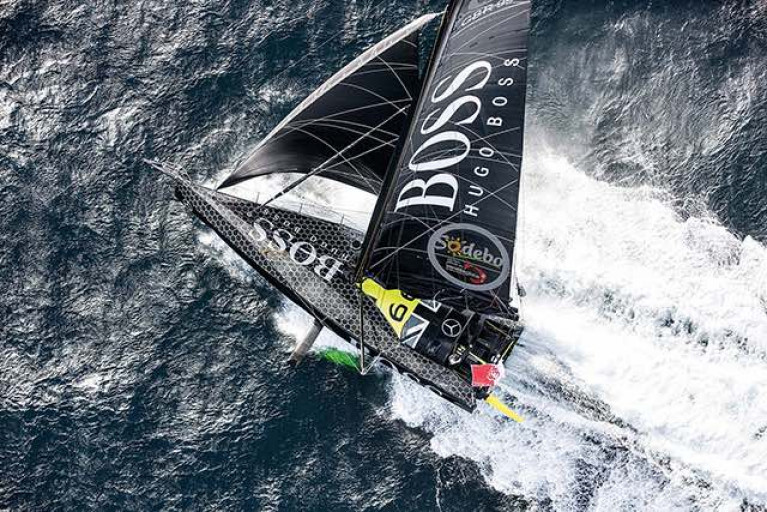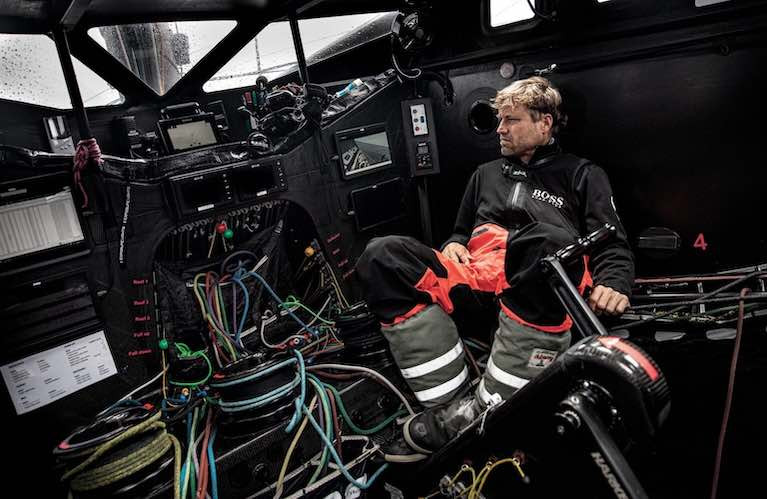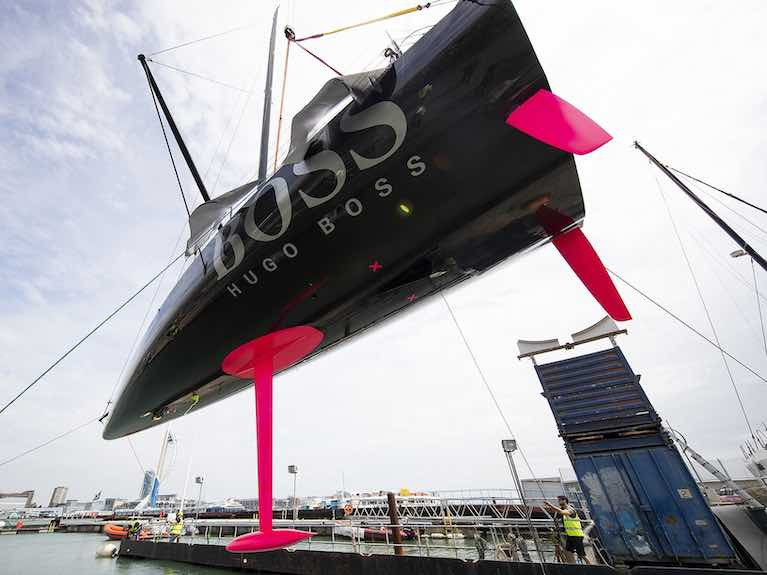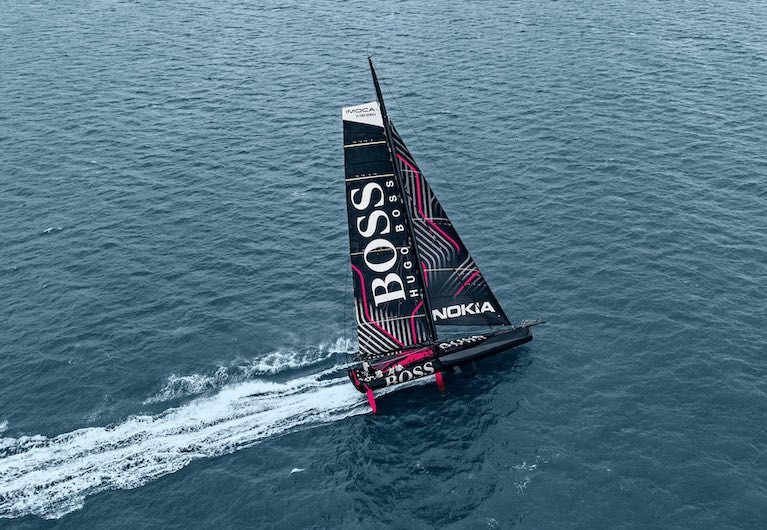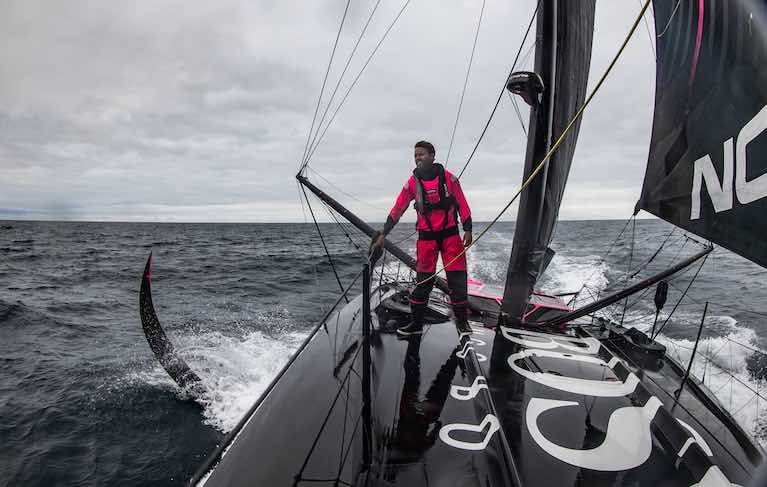Displaying items by tag: Alex Thomson
Alex Thomson Buys Contentious Vendée Globe IMOCA 60
Welsh Solo offshore Alex Thomson, who has ties to Cork Harbour in Ireland, has bought Banque Populaire’s IMOCA 60 following the team’s withdrawal from the next Vendée Globe in 2024 due to the controversial circumstances over dropping female skipper Clarisse Crémer.
5 West Ltd, represented by British four-time Vendée Globe competitor Alex Thomson, announced it had reached an agreement with Team Banque Populaire on its social media channels earlier this week (21 March 2023).
Banque Populaire posted a similar message via its social channels, stating: Team Banque Populaire has concluded an agreement for the sale of its IMOCA with the company 5 West Ltd represented by A. Thomson, for a project which will allow a future skipper to participate in the Vendée Globe. [Banque Populaire] wishes them success in this new challenge.
Today I am excited to share with you a new @ImocaGS team @Canada_Ocean. I have partnered with skipper Scott Shawyer and will mentor him as he takes on the @VendeeGlobe in 2028.
— Alex Thomson Racing (@ATRacing99) August 23, 2022
So please like and follow @Canada_Ocean and join us our journey ?#CanadaOceanRacing https://t.co/YeVOxukGaS
The skipper has not yet been announced, although some fans are hoping that Clarisse Crémer might return to the helm of the boat for the 2024 event.
Crémer came 12th overall in 2020/2021 Vendée Globe and was the first woman to complete that iteration, becoming a record holder. She was shockingly dropped by her sponsor Banque Populaire in February (2023) after she gave birth to a baby girl in November 2022.
? Le Team Banque Populaire a conclu un accord de vente de son IMOCA avec la société 5 West Ltd représentée par A. Thomson, pour un projet qui permettrait à un prochain skipper de participer au Vendée Globe. La Banque de la Voile leur souhaite de réussir dans ce nouveau défi.
— Voile Banque Populaire (@VoileBanquePop) March 21, 2023
In October 2021, new rules were implemented to qualify for the Vendée Globe. Previously, finishers automatically qualified for the next edition. Now skippers must gain points by participating in intermediate races with only the first 40 qualifying. Crémer’s maternity leaves meant she couldn’t accumulate enough points.
The Route du Rhum carries a frustrating memory for British solo racer Alex Thomson. With a comfortable lead, on course for his first ever IMOCA major ocean race win, he slept through his electric shock watch alarm, and his IMOCA hit the island of Basse Terre. A consequent 24 hours penalty for using the engine to get off the rocks dropped Thomson to third and handed victory to Paul Meilhat.
After announcing a break from ocean racing to focus fully on family life and help other emerging teams, Thomson is back today in Saint-Malo, relaxed, happy and wearing the colours of Canada Ocean Racing, the outfit which his Alex Thomson Racing are mentoring towards the 2028 Vendée Globe.
“It is fantastic to be back.” Thomson volunteers, “Obviously there is a big part of me wants to be back doing this. But it is a pleasure to be back and see everyone and this is the first race start I have been to since the Vendée Globe. I have had a proper break.”
“For all the new boats, it is really touch and go if they even make it to the other side”
The IMOCA fleet has grown almost twofold since the 2018 race – his only Route du Rhum – when there were 20 boats on the start line. He concurs that many of the new, youngest IMOCAs might not make the finish line.
“Thirty eight IMOCAs is insane. What a fleet. Obviously, APIVIA, Charlie Dalin is the favourite. For all the new boats it is really touch and go if they even make it to the other side as they have not done the miles. Most people will take it quite carefully. I can imagine many going far to the north or even to the west. I think a few new boats will get there. I think Jérémie Beyou will make it and do well, he has Franck Cammas in his camp and that is one of the smartest moves ever.”
 Jérémie Byeou'ss Charal - The Frenchman is one of only a handful of sailors to have taken part in four Vendée Globes and is aiming for a fifth entry in the 2024-25 Vendée Globe race. His best position to date in the solo non-stop round the world race is a 3rd place that he picked up in the 2016-17 edition Photo: Eloi Stichelbaut
Jérémie Byeou'ss Charal - The Frenchman is one of only a handful of sailors to have taken part in four Vendée Globes and is aiming for a fifth entry in the 2024-25 Vendée Globe race. His best position to date in the solo non-stop round the world race is a 3rd place that he picked up in the 2016-17 edition Photo: Eloi Stichelbaut
Surveying the assembled fleet for the first time, he says, “I love Kevin Escoffier’s boat and technically, he is very good, and I can see him doing well. Of those new boats, Boris (Herrmann) might find it tough to get to the other side as he is on this schedule to get to Alicante directly for The Ocean Race start. And the other thing is these boats are doing 16-18kts upwind now, which is amazing.”
 Team Maliza Seaexplorer , Boris Hermann’s new IMOCA, designed for both The Ocean Race 2023 and the Vendée Globe 2024 by naval architects VPLP, was launched in Lorient on 19 July 2022 Photo: Antoine Auriol
Team Maliza Seaexplorer , Boris Hermann’s new IMOCA, designed for both The Ocean Race 2023 and the Vendée Globe 2024 by naval architects VPLP, was launched in Lorient on 19 July 2022 Photo: Antoine Auriol
Inevitably the questions about his 2018 accident are replayed. Four years on it still rankles that he was so close to winning his first ‘major’ with a huge lead, racing the fastest most optimised boat in the fleet.
“It is funny how everyone wants to remind me.” He smiles with his trademark grin, “ And that is fine. I describe touching Guadeloupe as ‘my most embarrassing public moment’. And what is great is it means I don’t have to talk about my other most embarrassing moment!. But it happened. I can never get away from it. I should have won that race and therefore I did not ever win an IMOCA race which grates, but everyone’s reaction was way better than I thought. And my reaction at the time? There was minutes between being told the outcome (of the Jury decision which penalised him +24hrs). The only thing at the time was not making it bad for anyone else.”
And looking back, he adds, “It doesn’t matter whether I think the penalty was fair or not. I gave them the opportunity to give me that penalty in the first place, stupidly. But that is life. But the reaction from the French public was great. And from that point of view as well, it is lovely to be back here on the docks and getting such a warm reception.”
Among his first visits on the IMOCA pontoon were Ollie Heer, the young Swiss skipper who was previously boat captain on Thomson’s IMOCAs and the young, 24-year-old Brit James Harayda.
“I am saying to them is ‘guys, don’t think about going west or north.” Thomson explains, “You have to finish and get the miles. Ollie is a really good sailor and a good communicator. I told him he had to quit working with me and get on and do it too. And I feel responsible as well a bit for James Harayda too as I kind of told him what he could do and how he could do it too. Now they have gone and done it too. It is great to see. And now, the pathway for them is to get to the finish, get the miles and find some money. They don’t need big, big budgets; they need funding.”
Has the landscape changed much for them compared to when Thomson was prepping his first IMOCA race? He responds: “ I think it is fairly similar. Going on board their boats today was a real déjà vu compared to my first Vendée Globe, but neither have anything on their job lists to be done. That brought me back, figuring out how to do stuff. There was never much help, and there is still a French/English thing. It is not easy. But the scale of the whole thing, these big races, and getting to the start of the Vendée Globe is a much bigger task on shore than on the water.”
Surveying the fleet, he concludes, “It is amazing to think of the next Vendée Globe with 38 boats here and seven more new ones coming. There are something like 56 active projects for the next Vendée Globe and that is great. And 40 boats in the Vendée Globe will be amazing. We always used to talk (as a team) about whether the slice of the pie we got became smaller the more boats there were. But 40 boats is great as long as it is safe. There are more people to follow and the whole thing is bigger. And I think for the sport to grow the whole idea of the IMOCA Globe Series is working.”
Vendee Globe Ocean Racer Alex Thomson Steps Down from Racing
British sailor Alex Thomson has announced he won't compete as a skipper in the 2024 Vendee Globe, the solo, non-stop race around the world, but doesn't rule out returning to the race in 2028. Thomson has competed in the IMOCA circuit for 19 years including five successive Vendee Globes with two podium finishes and numerous world records.
"I have had the privilege to compete and race IMOCA 60s for almost 20 years. I love the sport but it's now time for me to spend more time on land, with my young family. My wife Kate has single-handedly raised our children for the last 10 years whilst I have pursued my dream. Now I want to support Kate and allow her the same opportunity that she has given me. This doesn't mean that I am retiring, just changing my role, from spending most of my time at sea, to spending more of it on land."
Thomson and his team 5 West Ltd will remain together, "The goal has always been to win the Vendee Globe, which to me remains the toughest sporting challenge left in the world today, and we haven't accomplished that yet. This is the start of a new chapter, with a new skipper, and we will provide him or her with all the tools, knowledge, experience and environment to win."
Skipper Alex Thomson Returns home To Gosport Onboard Hugo Boss
Alex Thomson and his crew today arrived back to their home base of Gosport, England having sailed close to 8,000nm from Cape Town onboard the HUGO BOSS boat.
After departing from Cape Town last month - following his retirement from the Vendee Globe round-the-world yacht race - the British skipper and his crew of three spent close to four weeks at sea, delivering the IMOCA racing yacht safely back to port.
The British ocean racing team will now undertake a routine service of the yacht on the UK's south coast before announcing their plans for 2021 and beyond.
"It's great to be back home. 8,000 miles - I've learned an awful lot, as we always do when we go sailing and I'm looking forward to looking back at that data and doing some analysis" said Thomson.
"For me now, I'll go home and spend some time with my family. HUGO BOSS will come out of the water and go into a service, which shouldn't take long. No major issues to report, apart from a bit of a tidy up of the repair I've done and then we'll be back in the water very soon.
"I know a lot of you have been asking what's next for me and the team. Well, there's a lot to think about. There are a lot of opportunities and I'll be sitting down with my team over the next few weeks to talk about it. So as soon as I know…you'll know!"
Alex Thomson Arrives in Cape Town & Formally Retires From Vendee Globe
Each edition of the Vendée Globe, Cape Town, South Africa provides final safe haven for stricken solo racers to retire to, restore their mental equilibrium, to reflect on what should have been and to enjoy the safety and security of terra firma after nursing an injured IMOCA to port.
After nearly seven days and 1,800 miles since he announced his hopes of winning the 2020 Vendée Globe had been terminated by a broken starboard rudder, Alex Thomson arrived in Cape Town this morning. He will be joined over the weekend by the young Vendéen skipper, Sébastien Simon, who also announced he has had to give up the race because of damage to his starboard foil casing and his foil on the Juan K designed ARKEA PAPREC.
Of the 33 IMOCAs which started the race, four have now officially abandoned, CORUM L’Épargne, PRB, HUGO BOSS and ARKEA PAPREC.
Thomson said, “I’m still coming to terms with what’s happened, and I’m obviously utterly devastated that this is how the race has ended for us.”
“But, as I’ve said before, it’s in our toughest moments that we find our greatest strength. Now we have to pick ourselves up and move forwards, and I’ve no doubt that we can do that together as a team. Over the past week or so we’ve been reminded of just how difficult this race is. I’ve said it time and time again but there really is no sporting challenge in the world as tough as the Vendée Globe. I have such admiration for any skipper who takes on this race. My thoughts go out to those who, like us, have had their races cut short. And I wish the remaining skippers a safe passage and a good race. I’ll be watching closely.”
The British skipper has been forced into Cape Town in early December before. His first Vendée Globe ended with his retiral on 7th December 2004 after an area of his coachroof around the mast gave way due to a structural problem. And in 2006 he and Mike Golding arrived in Cape Town on December 3rd 2006 after Golding had dramatically rescued Thomson from his IMOCA in the Southern Ocean after he had to abandon it because his keel had failed. Golding’s mast broke not long after the rescue and the pair had to sail 1000 miles north under jury rig.
Britain’s Sam Davies is making steady progress north under reduced sail nursing her damaged Initiatives Coeur back to sheltered waters and this afternoon was about 80 miles south of Cape Town. After the best sleep since she hit a floating object which has damaged the structure round her keel, Davies admitted that the emotions were suddenly released as she was accompanied on her route by an albatross, “The sun came out too which helps to ease the aches and pains - I went and sat outside in the warm sun. And then suddenly found myself in floods of tears - and this is a bit weird for me, who never cries, to deal with all these emotions. I wasn’t even sure why I was crying - whether it was sadness for my boat and for my place in this race, or relief that my boat and I are safe? Or a mix of all these emotions? I’ve always felt that it’s stupid to cry when you are alone on your boat - nobody’s going to help you or hug you or reassure you so it’s pretty much a waste of time and energy. But at that particular moment I had no control over these emotions. I leant on the coach roof and looked out and there, right there, really close, unusually close, was the most beautiful albatross I have seen, gliding past silently and slowly. He was so close. Normally the albatrosses keep their distance but this was different, as if he could feel my emotion and wanted to help. He stayed close and gave me a wonderful display of effortless flight that was a welcome distraction. They say that albatrosses have the souls of sailors of the past and I can well believe that. I feel like I am being escorted to safety by these amazing creatures and I am grateful for their concern!”
Meantime, yesterday night, Romain Attanasio (Pure-Best Western), Davies’ partner was nervously crossing the exact same zone where she had her collision two days ago and where four years ago he hit something which damaged his rudder, requiring him to repair at anchor off Port Elizabeth.
“I am fully in the zone where Sam and Seb hit their OFNIs and it is exactly the same area as I did four years ago, the same spot same latitude, same longitude it is in the Agulhas current, there are all sorts of things in the water, objects, it is a zone which is a bit critical. I am reaching in quite a big sea and so I am on high alert. I have my eyes on OSCAR as much as possible, this camera system that surveys the route. You can’t see much in the water on the surface. So, it is not easy all this.” said Attanasio.
Conditions are still demanding for the fleet leaders who will shortly be able to angle more to the south east after passing the corner of the Antarctic Exclusion Zone. Led by Charlie Dalin (Apivia) with Louis Burton now just 140 miles behind on Bureau Vallée, they are still all struggling to set a good average speed in the typically big seas and gusty winds. A second, deeper low pressure is set to combine next week to provide very testing conditions which it is most likely the leaders will change their route to avoid.
The top ten now contains a fascinating mix of solo racers, six of them racing in the ‘big south’ for the first time, Charlie Dalin, Yannick Bestaven, Damien Seguin, Benjamin Dutreux. Isabelle Joschke and Giancarlo Pedote and still three non-foiling boats, those of Seguin, Dutreux and Jean Le Cam.
Louis Burton’s attacking force seems relentless, his wife Servane noting today on the Vendée Live English programme, “Louis never stops surprising me, but he has a mind of steel. When he went south he asked me, ‘will you still love me if I screw up?’
Huge Support for Alex Thomson as he Heads for Cape Town After Vendee Globe Withdrawal
Charlie Dalin, the Vendée Globe race leader, should pass the longitude of the Cape of Good Hope on Monday, the first of the mythical 24,296 nautical miles solo round the world’s three Great Capes. That his elapsed time since the race started in Les Sables d’Olonne will be around 22 days might be of some tiny consolation to British skipper Alex Thomson who is heading to Cape Town.
His Vendée Globe may be over because of a broken rudder sustained on Friday evening but the blistering pace of 17 days 22hrs 58 seconds that Thomson leading the 2016-17 race remains intact, and is likely to remain so for at least another four years.
The bitterly disappointed 46-year-old from Gosport, Hampshire in England has explained briefly what happened to his rudder, believing that some discarded or lost fishing equipment caused the fracture.
“I was averaging 21 knots, flying the small gennaker and one reef in the mainsail. I was down below when there was a huge bang and the boat broached violently. The steering system was jammed and all I could do was roll the sails away. Once on deck, I could see the rudder blade was broken and swinging around with a large piece of fishing gear jammed into the cracks. So I think I must have hit something. It certainly looks that way. Now I am having to keep the boat flat while I sail the boat now with just one rudder to Cape Town.”
Even after losing four days and nights slowed to make structural repairs, Thomson was sure he had the capacity to win, “I still felt that we could win it, I really did “I’m obviously devastated.”
From the skippers still racing and fans and supporters around the world there has been a huge outpouring of support and good wishes for the popular skipper. French rival Jérémie Beyou, who restarted nine days after the original start due to damage to his own rudder on Charal send a message of solidarity to the sailor who should have been his closest rival on this ninth edition of the race.
Many race followers had expected and hoped for a Thomson v Beyou title match but the dreams of both race heavyweights are over. Beyou crossed the Equator today and is still over 350 nautical miles behind the 31st placed Kojiro Shiraishi and 3,300 miles behind Dalin, having restarted at 2,715 miles behind the then leader HUGO BOSS.
“It is so tough for Alex. I know how hard it is to be in his place. I have been there and even this time was just inches from being in the exact same situation. I know how hard it is to prepare a Vendée Globe and to do it, three, four, five times, to be there to try and always be reaching that holy grail, that first place. I know all the things he has had to do to prepare his boat, all he has been through to get here, and then he has nothing, no comeback, no closure. I feel so bad for him as bad as if it were happening to me. He called me when I had to turn back and he had some very nice words to say. I told him yesterday to hold his head high because there will be time to analyse it all, but all that he has done to prepare this race is something to be proud of.” Said Beyou when he spoke on the Vendée Globe Live show this lunchtime.
He added, “Hearing Damien Seguin talk earlier and seeing the conditions they have in the Southern Ocean makes me really want to be with those friends up ahead; it is not so easy to be this far behind. I am trying to make the boat go as fast as possible and have chosen a course that is direct down the Atlantic and cut off the corner."
Dalin’s lead remains steady at around 300 nautical miles ahead of Thomas Ruyant (LinkedOut) while Jean Le Cam (Yes We Cam!) and Kevin Escoffier (PRB) have been trading third place over the course of Sunday.
Among those who remain impressive as first timers in the south are Yannick Bestaven in fifth on Maître CoQ IV, pushing Escoffier hard. Sébastien Simon on the new Juan K designed ARKEA PAPREC has been quick and making steady inroads now in seventh chasing sixth placed Louis Burton (Bureau Vallée 2) who is just 11 miles ahead. Paralympic medallist Damien Seguin is outstanding in ninth driving his powerful, non-foiling 2008 Finot Conq designed Groupe Apicil very hard indeed, likewise Les Sables d’Olonne rookie Benjamin Dutreux on the Farr designed OMIA-Water Family is in 12th, just six miles behind Sam Davies who is 11th on Initiatives Coeur.
Hugo Boss & Alex Thomson Out of Vendee Globe Race
Alex Thomson, the pre-race favourite to win the Vendee Globe, is out of the non-stop round the world race this afternoon after suffering rudder damage in the Southern Atlantic.
The British sailor is heading for Cape Town after a week of setbacks on his boat Hugo Boss.
The incident occurred on what was Thomson’s 19th day of racing, and it followed significant effort over the last five days and nights repairing cracks to the internal bow structure of his boat. Thomson was getting into his stride at the gateway to the Roaring Forties where his latest generation IMOCA was designed to be at its best.
Alex is currently 1,800 nautical miles from Cape Town and it is expected to take him around seven days to make the journey.
The British skipper, who was racing in the Vendée Globe for the fifth time, had received huge support and respect from around the world for the efforts he made to repair the bow area but there was no way to safely fix the rudder damage to allow him to race on for the what would have been the best part of one month in the hostile Southern Ocean.
Alex Thomson said, “Unfortunately, a repair is not possible. We therefore accept that this will be the end of the race for us. Myself, my team and our partners are of course deeply disappointed. We believe the best was yet to come in this race”
One of the two outstanding favourites to win this Vendée Globe, Thomson was third on the 2012-13 edition and finished second in 2016-17 after fighting back from being 48 hours behind eventual winner Armel Le Cléac’h at Cape Horn to finish only 16 hours behind the French skipper.
Luck has rarely run in his favour on this non-stop solo round the world race. In 2004-5 on his first attempt he had to abandon into Cape Town with damage to his deck after his boom gooseneck failed and in 2008-9 he had to retire early in the race with structural problems caused by a huge gale on the Bay of Biscay.
A statement from Alex and the team:
*******************
After incurring damage to the starboard rudder of the boat, Alex has ceased racing in the Vendée Globe and is now sailing the boat towards Cape Town.
Alex last night disconnected the starboard rudder and has since been sailing the yacht with just one rudder. After assessing the situation today, Alex and the team have decided that the only course of action is to cease racing and sail the boat to Cape Town.
Alex said: “Unfortunately, a repair is not possible. We, therefore, accept that this will be the end of the race for us. Myself, my team and our partners are of course deeply disappointed. We believe the best was yet to come in this race”.
Alex is currently 1,800 nautical miles from Cape Town and it is expected to take him around seven days to make the journey. He’ll do so without the use of his starboard rudder and so will proceed safely and cautiously.
Our technical team will travel to Cape Town to meet the yacht upon arrival.
On behalf of Alex and the team, we thank you for your support during this time.
Alex Thomson Reports Rudder Damage to Hugo Boss in Vendee Globe
Vendee Globe competitor Alex Thomson Racing has issued an alert describing rudder damage to Hugo Boss which is reported to have occurred around 1900hrs UTC this Friday evening.
Thomson has control of the yacht with one rudder, and is safe and in no danger onboard.
Thomson is racing in 12th position and was doing around 10kts in an easterly direction on the 21hrs TU position report.
Race tracker observers had noticed he was quite slow last night. Now he is averaging 10 knots when all those around him are averaging 17 knots. It is likely his starboard rudder is disconnected as they are all on port gybe at the moment and that would mean his port rudder would be out of the water if he allowed the boat to fully heel.
A team statement reads as follows: at approximately 19:00 UTC this evening Alex Thomson notified his technical team onshore of damage to the starboard rudder of his HUGO BOSS boat. The team immediately advised Thomson to disconnect the rudder to regain steerage. He now has control of HUGO BOSS with one rudder and is safe and in no danger onboard. The team is working to assess the extent of the damage. A further update will be released on Saturday 28th November.
It is yet another set-back for the British skipper the round the world race. The last four days were spent making repairs to the bow after a structural failure cost Hugo Boss the race lead.
Vendée Globe Skipper Alex Thomson Forced To Slow Down to Make Repairs
British Vendée Globe skipper Alex Thomson has today been forced to slow his HUGO BOSS to a crawl as he attempts to make a technical repair to a longitudinal beam near the bow of his IMOCA.
As Afloat reported earlier, Thomson alerted his team to the problem around 1900 UTC Saturday evening after a routine inspection raised immediate concerns as he raced south-eastwards towards the Southern Ocean part of the leading trio of boats racing south-eastwards some 850 nautical miles east of Rio de Janeiro, Brasil.
With the imminent requirement to plunge south for more than one month in the inhospitable waters between the Cape of Good Hope and Cape Horn, the 46-year-old British skipper will want to have complete faith in the repairs and in his IMOCA. But a statement issued by his Alex Thomson Racing Team this morning confirms he has the materials and the methods to effect the necessary repairs and aims to be back on course as quickly as possible.
 Alex Thomson on Hugo Boss
Alex Thomson on Hugo Boss
“Alex has now put the boat into a safe position to manage the sea state in order to reduce movement onboard while he carries out the repair. He has all the necessary materials onboard, a detailed plan to follow, and a team of world-class engineers advising him. We are therefore confident in his ability to complete the repair. Our objective is to carry out the necessary repair swiftly and effectively, in order to minimise the miles lost and resume racing again.” Said Alex Thomson’s Racing’s Technical Director Ross Daniel.
Having been in second place in the 33 boat fleet during Saturday, averaging 16kts at times and some 25 nautical miles behind leader Thomas Ruyant, Thomson’s pause had already cost him 150 miles on Ruyant and Charlie Dalin (Apivia) who passed into second 23 miles to windward of the British skipper around midnight last night.
“Supposing it takes Alex 24 hours to effect a repair and get going again he would rejoin the chasing group with Arkéa Paprec, Initiatives Cœur and PRB, he would lose quite a bit as that would put him 1000 miles behind at Cape of Good Hope. But I have been looking at the history of the race as well and remember that last time on the last race he rounded Cape Horn 800 miles behind Armel Le Cléac’h and so I would not call this ‘game over’". Suggested Yoann Richomme, winner of the last Route du Rhum in Class40 and double winner of La Solitaire du Figaro when he was today’s guest on the Vendée Globe LIVE English programme.
Talking about the latest generation of fast foilers Richomme, renowned as a meticulous technician, explained, “These new boats are really tough to sail, they are really hard to engineer and are slamming into the waves with a lot of power, which is most likely happened to Alex. What is hard is that we know that they took their feet off the gas a little in the south on the last race to preserve the boats last time, and I think they will be doing that again. From the scenario we are seeing they need to preserve the boats. When these boats start taking off, they were slamming the hulls a little bit further back but now these boats are fully foiling, flying a lot of the time, it is now the bows which are hitting the waves in front, from 2-3m high at times and the impact on the bows is huge and we know a lot of the boats in France had reinforcements in the bow. We saw CORUM L’Epargne in September have a two-week repair in their bow. They are discovering new problems and we are hoping they have covered off most of them.”
At two weeks since the race started off Les Sables d’Olonne on Sunday 8th November there are many repairs, small and not so small, critical and almost incidental, that skipper need to make. Contemplating the descent into the Southern Ocean race leader Thomas Ruyant (LinkedOut) had to climb the 28m mast of his IMOCA after his spare halyard broke. The two leading IMOCAs, LinkedOut and Apivia are side by side 10 miles apart setting out on a gybing match up as they drop south-eastwards towards an area of unstable air, described by Dalin as ‘mousehole’ through which they must pass to get to the Southern Ocean and a fast ride east towards the longitude of the Cape of Good Hope.
Now the Vendée Globe fleet stretches for more than 3000 miles, Jérémie Beyou in 32nd, has lengthened his stride in the south of the Canaries. Listening to the skippers on the daily calls or reading the messages sent from on board, whatever the age of the boat or its position on the Atlantic chessboard, every day brings its share of problems. Yesterday it was a weather vane for ninth-placed Sébastien Simon, today a composite repair on a part of the foil well for Armel Tripon on L’Occitane and that week-long repair to the mainsail of the Japanese Kojiro Shiraishi. Big or small the problems prevail through the fleet.
Armel Tripon, the skipper of L’Occitane en Provence, reflects, “The boats want to go fast, the chase their predicted speeds and they are built for that and the teams and the architects are pushing all the time to go fast. Now it's up to each of us to sail with our soul and our own peace of mind ".
Alex Thomson Expected to Increase Vendee Globe Lead
As he leads onto the trade winds motorway down the Atlantic, between the Canary Islands and the Cape Verdes, British skipper Alex Thomson is expected to increase his lead at the head of the Vendee Globe fleet as his foiling Hugo Boss hits its stride.
Accelerating through the day Thomson has shaken off veteran Jean Le Cam, averaging two knots faster, and is the only skipper in the race to have sailed more than 380 nautical miles in the last 24 hours.
NEE’ly Trade winds of 20-22kts are expected to blow for Thomson and the leading peloton over the coming days. Sunday, one week into the race, has offered many skippers in the top group to take essential time to look after themselves, to wash, to make a ‘treat’ meal or drinks, to change into fresh clothes, as they prepare for what will still be a demanding, active period, even if it is a boatspeed drag race on port gybe for several days.
“You can’t forget the trade winds are not as stable as you maybe think, the direction still changes ten to fifteen degrees and the wind will go up and down, there are still gusts and so you have to be attentive and there will be a lot of trimming to do.” cautioned Seb Josse, who is serving as one of the Vendée Globe’s meteo advisers.
Skippers today expressed their admiration for Thomson’s race so far.
“He has mastered the start of this race perfectly with his ingenious, efficient and well-prepared boat,” commented guest of the Vendée LIVE French show this afternoon. “Alex is going to take the fast train south and that can quickly turn into a big lead,” notes Thomas Ruyant from fourth placed LinkedOut at over 120 miles behind Thomson. “And Alex is hungry for it, but so am I.”
One of the pre-race favourites Charlie Dalin, in sixth at 168 miles adrift of HUGO BOSS, wants to stay in the match but acknowledged: "My decision to move out west was because the storm was too early on into the race to take any risks and I did the calculation of what I could afford to lose and try and make up, Alex went full on in the Theta depression and that can give him to make a big margin". Dalin, the Apivia skipper chuckled on the live show "Wait for me guys, I am stoking up the coal, I'm coming! "
HUGO BOSS is due at the latitude of the Cape Verde islands tomorrow and is expected to pass the doldrums on Tuesday. According to Vendée Globe weather specialist Christian Dumard the leaders may be treated to a relatively straightforward crossing into the Southern Hemisphere.
At the Port Olona pontoon in Les Sables d’Olonne, the technical team of experts have been working round the clock onboard Charal, the damaged IMOCA of Jérémie Beyou, aiming to have it ready for Beyou to return to the course. A press conference is planned for 1700hrs CET Monday to announce the decision.
Japanese skipper Koji Shiraishi has managed to lower his damaged mainsail on his DMG MORI and is evaluating the options to repair the tear.
TREATS ALL ROUND
Skippers have been rewarding themselves as they break into warmer climes. "It has been the first day with some time for me, it feels good," admitted third placed Benjamin Dutreux (OMIA - Water Family). “I have been on the terrace (cockpit) having a good coffee”. Each has enjoyed their own way of treating themselves, Alan Roura (La Fabrique) had his first shower, 1 litre of salt water then 1 litre of fresh water. Yannick Bestaven (Maître CoQ IV) took the time to listen to a "rock" playlist, Boris Herrmann "had a little aperitif and called up his friends".
Damien Seguin, slept seven hours last night, treated himself to a small feast with Parmentier hash and Beaufort cheese. Sunday morning, Manuel Cousin (SÉTIN Group) started the day with a good roasted coffee - “just like at home” - and a piece of chocolate from a chocolate maker sponsor. Clarisse Crémer (Banque Populaire X), too, looked more relaxed. On the deck of her IMOCA she was appreciating the beautiful seascape, "This is the picture-postcard image that you have in your mind of ocean racing.” Said the skipper who admitted to being ‘a bit freaked out’ by the prospect of dicing with the storm Theta, “It feels good to have a lighter heart! "


























